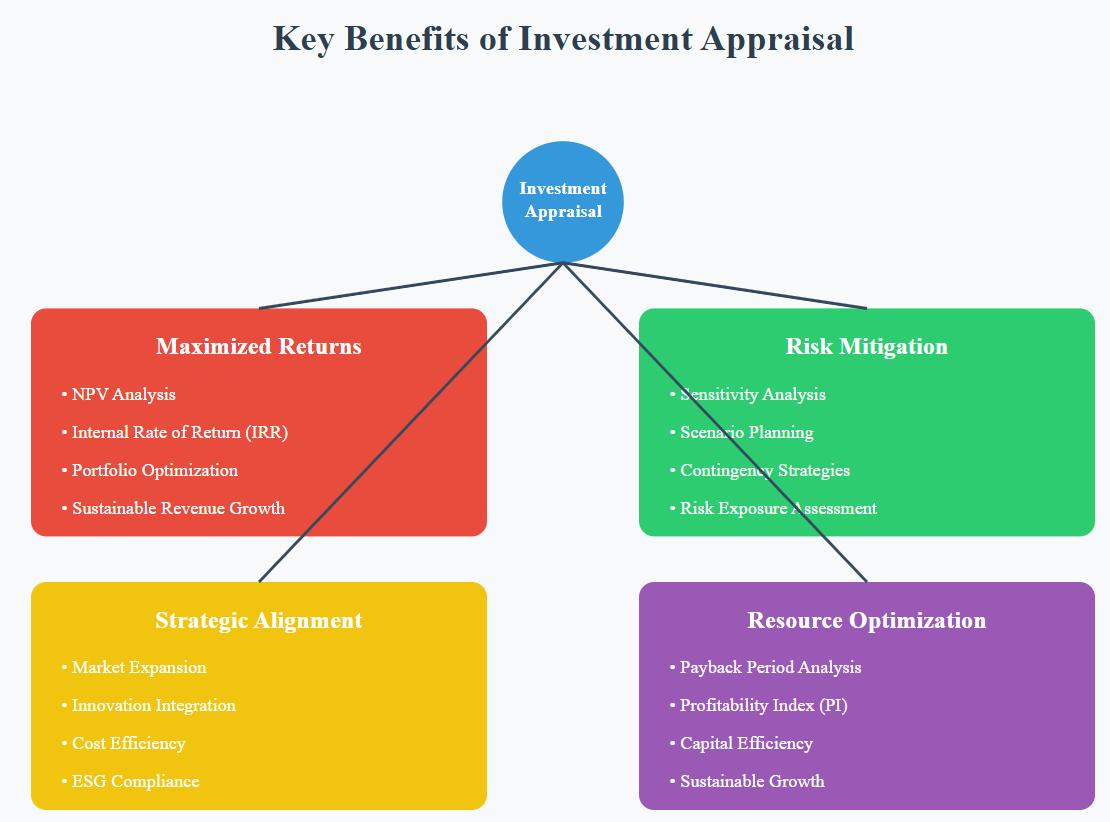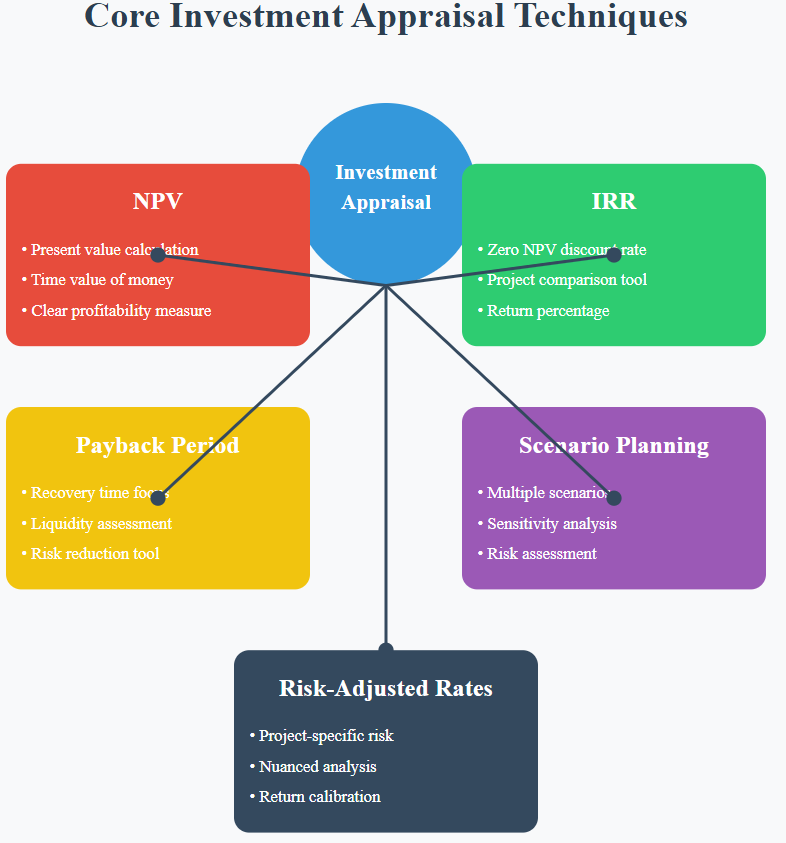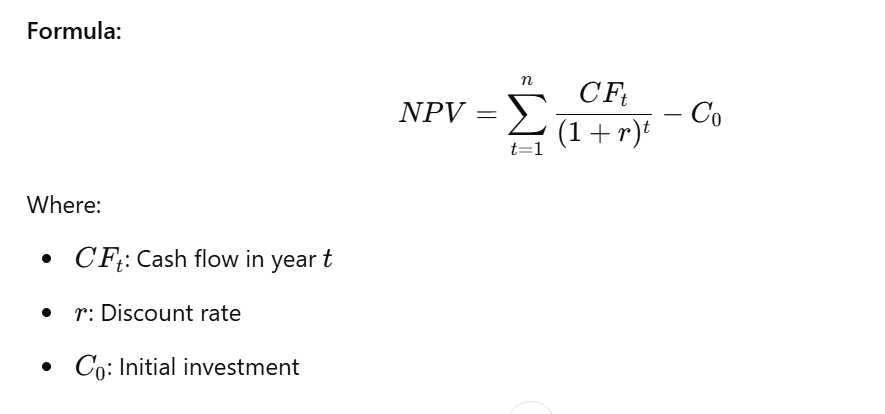
Investment Appraisal Techniques: Empowering Executives to Make Strategic Decisions


Key Benefits of Investment Appraisal

Maximized Returns
Investment appraisal enables organizations to systematically evaluate multiple projects and identify those that generate the highest financial and strategic returns. By leveraging techniques like Net Present Value (NPV) and Internal Rate of Return (IRR), decision-makers can quantify profitability, ensuring that capital is allocated to ventures with strong potential for sustainable revenue growth. Moreover, businesses can optimize portfolio performance by balancing short-term gains with long-term value creation.
Risk Mitigation
Every investment carries inherent risks, including market volatility, regulatory changes, and operational disruptions. Through sensitivity analysis and scenario planning, organizations can assess potential pitfalls before committing capital. These techniques help executives identify worst-case scenarios, quantify risk exposure, and develop contingency strategies such as hedging, insurance mechanisms, or phased investment approaches. By proactively addressing risks, companies can protect financial stability and enhance investment resilience.
Strategic Alignment
Investment decisions must align with an organization’s broader objectives, such as market expansion, innovation, or cost efficiency. Investment appraisal ensures that each financial commitment supports the company’s strategic priorities. For example, a firm seeking to enter new geographic markets can use risk-adjusted discount rates to compare potential expansion projects, selecting the one that best balances opportunity and risk. Additionally, companies investing in sustainability initiatives can evaluate projects not only on financial returns but also on long-term impact and compliance with environmental, social, and governance (ESG) criteria.
Resource Optimization
Capital is a finite resource, and poor allocation can lead to inefficiencies, cash flow constraints, or even financial distress. Investment appraisal techniques help organizations prevent overinvestment in low-yield projects and reallocate funds to initiatives that generate higher returns per unit of capital deployed. Payback period analysis ensures that liquidity needs are met, while profitability index (PI) helps compare multiple projects to determine the most efficient use of resources. This disciplined approach enhances financial agility and supports sustainable business growth.
Core Investment Appraisal Techniques
- Net Present Value (NPV): Evaluates the value creation potential of an investment by calculating the present value of future cash inflows and outflows. This approach accounts for the time value of money, offering a clear measure of profitability.
- Internal Rate of Return (IRR): Determines the discount rate that makes the NPV of a project equal to zero, reflecting its expected return. IRR is especially useful for comparing projects of similar scale.
- Payback Period Analysis: Focuses on liquidity by calculating how quickly an investment can recover its initial cost. While simple, this method emphasizes risk reduction and cash flow management.
- Scenario Planning and Sensitivity Analysis: Explore best-case, worst-case, and base-case scenarios to understand potential variability and resilience of investments under changing conditions.

- Net Present Value (NPV): Evaluating Value Creation
NPV calculates the present value of cash inflows and outflows over a project’s lifetime, discounting future cash flows to reflect the time value of money.

Advantages:
- Considers the time value of money.
- Provides a clear measure of value creation.
- Internal Rate of Return (IRR): Measuring Profitability
IRR is the discount rate that makes the NPV of an investment equal to zero. It indicates the project’s expected return and helps compare multiple investment opportunities.
Advantages:
- Easy to communicate as a percentage return.
- Effective for comparing projects with similar scales.
- Payback Period Analysis: Focusing on Liquidity
The payback period measures how long it takes for an investment to recover its initial cost. While simple, it emphasizes liquidity and risk reduction.

Advantages:
- Easy to calculate and understand.
- Useful for liquidity-focused decisions.
In addition to financial metrics, assessing risks is vital to ensuring investment success. The Investment Appraisal Techniques help executives to identify, evaluate, and mitigate risks associated with investments include:
- Sensitivity Analysis: Examines how changes in key variables, such as revenue growth or cost of capital, impact project outcomes.
- Scenario Planning: Models best-case, worst-case, and base-case scenarios to understand potential variability.
- Risk-Adjusted Discount Rates: Adjusts the discount rate to account for project-specific risks.
- Scenario Planning
Scenario planning involves constructing multiple “what-if” scenarios—such as best-case, worst-case, and base-case—to simulate how an investment might perform under varying external and internal conditions. By exploring these possibilities, executives can:
- Assess Resilience: Determine whether an investment can withstand adverse market conditions, such as economic downturns, regulatory changes, or supply chain disruptions.
- Identify Opportunities: Pinpoint scenarios where investments outperform expectations, allowing organizations to capitalize on high-growth opportunities.
- Develop Contingency Plans: Prepare proactive strategies for mitigating risks or maximizing gains based on likely scenarios.
5. Sensitivity Analysis
Sensitivity analysis complements scenario planning by examining how changes in individual variables—such as interest rates, raw material costs, or sales volumes—impact an investment’s financial performance. This method provides a deeper understanding of:
- Key Drivers: Pinpointing which variables have the most significant influence on outcomes.
- Risk Exposure: Identifying factors that could jeopardize the project’s profitability.
- Decision Support: Offering executives a clear picture of the risks and rewards associated with different strategic choices.
- Risk-Adjusted Discount Rates
The use of Risk-Adjusted Discount Rates (RADR) allows organizations to refine their investment appraisal process by incorporating project-specific risks into the evaluation. Unlike a standard discount rate, a risk-adjusted rate reflects the unique uncertainties associated with a particular investment, providing a more nuanced analysis of potential returns. Key Features of Risk-Adjusted Discount Rates include:
- Tailored Risk Assessment: RADR accounts for the specific risks tied to an investment, such as geopolitical instability, technological uncertainties, or market volatility.
- Accurate Valuation: By applying higher discount rates to riskier projects, organizations ensure that only the most robust opportunities are pursued.
- Comparative Analysis: Allows executives to compare investments with varying risk profiles on a consistent basis.
Aligning Investment Decisions with Strategic Goals
For an investment to be truly successful, financial viability alone is not sufficient—it must also support the organization’s broader strategic aspirations. Effective investment appraisal techniques ensure that financial decisions contribute meaningfully to long-term growth, competitive positioning, and operational efficiency while maintaining financial discipline.

Supporting Long-Term Growth and Market Leadership
Balancing Immediate Returns with Sustainable Value Creation
Ensuring Strategic Fit in Decision-Making
Outcomes of Mastering Investment Appraisal Techniques

1. Confident Decision-Making
Executives operating in complex and dynamic business environments must make high-stakes investment decisions with precision. By mastering techniques such as Net Present Value (NPV), Internal Rate of Return (IRR), and Sensitivity Analysis, decision-makers gain the ability to:
- Assess financial viability and strategic alignment simultaneously.
- Evaluate multiple investment scenarios using data-backed methodologies.
- Justify investment decisions with clear, quantitative insights, improving stakeholder confidence.
For example, in industries like renewable energy or pharmaceuticals, where projects involve high uncertainty and long-term payback periods, executives who are proficient in risk-adjusted discount rates and scenario planning can make confident investment choices that ensure both financial stability and competitive advantage.
2. Optimized Capital Allocation
Efficient capital deployment is key to maximizing returns and maintaining financial health. Investment appraisal techniques enable executives to:
- Prioritize high-yield investments that align with corporate strategy.
- Avoid overinvestment in low-impact or underperforming projects.
- Enhance resource efficiency, ensuring that funds are directed to initiatives that drive both immediate and long-term growth.
For instance, a global retailer considering expansion into emerging markets may use NPV and scenario analysis to determine the most profitable locations. By incorporating variables such as consumer demand trends, regulatory conditions, and operational costs, the company can allocate capital to markets with the highest potential for long-term revenue growth and brand expansion.
3. Enhanced Risk Management
Investment appraisal techniques integrate risk assessment into financial decision-making, allowing executives to:
- Identify financial and operational risks early in the process.
- Develop mitigation strategies, such as hedging against foreign exchange fluctuations or restructuring project financing.
- Adapt to changing market conditions by leveraging real-time financial modeling and stress testing.
For example, a manufacturing company investing in automation technology might use sensitivity analysis to assess how fluctuations in supply chain costs, labor availability, and energy prices impact investment feasibility. By quantifying potential risks in advance, companies can implement contingency plans, ensuring resilience against market disruptions.
Examples of Investment Appraisal Techniques in Action
1. Free Zone Authority: Aligning Projects with Economic Growth Goals
Free Zone Authorities employ Net Present Value (NPV) analysis to evaluate infrastructure development projects aimed at supporting national economic diversification. By calculating the discounted cash flows for multiple projects, the authorities prioritize investments in for example warehousing and eco-friendly logistics facilities, which yield positive NPVs. This approach ensures the allocation of resources to initiatives with high long-term value and environmental sustainability.
2. Healthcare Sector: Accelerating Telemedicine Adoption
Healthcare providers can use the Payback Period Analysis to assess the financial feasibility of a telemedicine platform. By focusing on how quickly the initial investment could be recovered, the organization determined that the project would achieve payback within three years. Combined with sensitivity analysis to account for adoption rate variability, this appraisal enable the providers to launch the platform confidently, enhancing patient access to care while minimizing financial risks.
3. SABIC: Driving Innovation with Risk-Adjusted IRR
SABIC, the Saudi-based global petrochemical company, employs Internal Rate of Return (IRR) analysis to evaluate investments in green technology R&D projects. Using risk-adjusted discount rates, SABIC accounts for the uncertainties associated with market adoption and technological breakthroughs. The company prioritizes projects according to their IRR ensuring alignment with its sustainability goals and generating substantial long-term value.
4. Retail Sector: Optimizing Expansion Strategies
Retailers implement scenario planning alongside NPV and IRR analysis to evaluate potential store expansions in emerging markets. By modeling best-case, worst-case, and base-case scenarios, the retailers identify markets with the highest financial and strategic potential.
5. Energy Sector: Evaluating Renewable Energy Projects
Energy companies applied Net Present Value (NPV) and sensitivity analysis to assess investments in solar and wind energy projects. By analyzing factors such as regulatory incentives and fluctuating energy prices, these companies identify the projects with the most stable returns.
Conclusion

Practical Application in Coaching
Useful Pages
E-mail: info@nbglobalconsulting.com
2025, NB GLOBAL CONSULTING. All rights reserved. Made with ❤️ by ROSA eSolutions.


